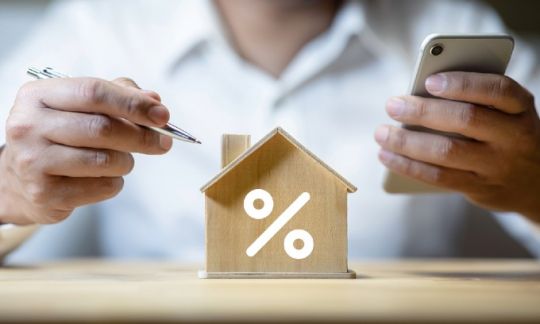How much more could your mortgage repayments increase in 2023?

The big four banks are predicting rates hikes are not over yet. Find out how high they think the cash rate will go and how much more your repayments could increase. Plus, Effie Zahos shares her tips on how to prepare for the extra cost.
Aussie borrowers had it good for quite a long time. May 2022 was the first time the Reserve Bank increased the cash rate in more than 11 years. Since then, though, we have had rate hike after rate hike. In just 10 months the cash rate has gone from 0.10% to 3.60% and many borrowers have felt the pinch. The bigger the mortgage the bigger the pain.
And it’s likely that there will still be more pain to come. Let’s take a look at how high the major banks are forecasting the cash rate will go and what it may mean for your repayments.
How high do the big four banks think the cash rate will go?
Commonwealth Bank: 3.85%
Most borrowers are probably hoping that the Commonwealth Bank has got it right as its forecast is the lowest of the four. CBA predicts there will be one more rate hike in April and the cash rate will peak then at 3.85%. It expects the cash rate will start dropping in late 2023.
ANZ: 4.10%
ANZ expects the cash rate to peak at 3.85% in May 2023 and forecasts it will stay at that level until November 2024 when it thinks we will see the first cash rate cut.
NAB: 4.10%
NAB also thinks there is more room to move and predicts the cash rate will peak at 4.10% in May 2023 where it will stay all year. NAB doesn’t expect rates to start falling until early 2024.
Westpac: 4.10%
Like ANZ and NAB, Westpac is forecasting the cash rate will peak at 4.10% in May. Westpac expects the cash rate will remain steady for the rest of 2023 before beginning to fall in early 2024.
How much could your repayments still increase based on the big banks’ rate forecasts?
It’s always good to plan ahead so Canstar crunched the numbers to give you an idea of how much your mortgage repayments could increase based on the various forecasts and assuming the rate increases are passed on in full.
Let’s start with the best-case scenario – Commonwealth Bank’s prediction that rates will peak at 3.85%. As the table below shows, this would mean that someone with a $600,000 mortgage over 30 years who is currently paying 6.19% interest will see their monthly repayments increase by $98 a month to $3,769. Someone with a $1 million mortgage will need to find an extra $163 a month.
If ANZ, NAB and Westpac are right, the cash rate will peak at 4.10% in May 2023. That would mean that someone with a $600,000 mortgage will have to fork out an extra $197 a month while someone with a $1 million mortgage can expect to pay $328 more a month.
Home loan repayments based on major bank peak cash rate forecasts
← Mobile/tablet users, scroll sideways to view full table →
| Loan amount |
Current monthly repayment (6.19%) |
CBA peak forecast 3.85% (Apr 2023) |
ANZ, NAB, and Westpac peak forecast 4.10% (May 2023) |
||
|---|---|---|---|---|---|
| Monthly repayment |
Increase | Monthly repayment |
Increase | ||
| $400,000 | $2,447 | $2,513 | $66 | $2,578 | $131 |
| $500,000 | $3,059 | $3,141 | $82 | $3,223 | $164 |
| $600,000 | $3,671 | $3,769 | $98 | $3,868 | $197 |
| $700,000 | $4,283 | $4,397 | $114 | $4,512 | $229 |
| $800,000 | $4,895 | $5,025 | $130 | $5,157 | $262 |
| $900,000 | $5,506 | $5,653 | $147 | $5,802 | $296 |
| $1,000,000 | $6,118 | $6,281 | $163 | $6,446 | $328 |
Source: www.canstar.com.au – 8/03/2023. Calculations are based on adding the major banks’ forecasted cash rate increase to the average overall variable rate (5.94%) on Canstar’s database available for a loan amount of $500,000, 80% LVR and principal & interest repayments; excluding introductory and first home buyer only loans with the March 2023 cash rate increase (0.25%) applied. Calculations assume a 30 year loan term.
Tips to help you find the extra money
Being prepared for what may come ahead will give you the best chance of not ending up in mortgage stress. So, it’s important to not bury your head in the sand and start taking the steps now that can help put you in a better position to meet higher repayments.
Review your budget
The first step is to take a look at your budget – especially if you haven’t done this in a while. It’s important to have a list of all your current expenses (this will help you identify where you could potentially save some cash) and also have an understanding of how much you have ‘left over’ each fortnight or month. Will you have enough money to cover the higher repayments based on the worst-case scenario?
Get a better rate on your home loan
One way to find extra savings is to try to secure a better rate on your mortgage. Often the best way to do this is to refinance because new customers tend to get a better deal than existing ones. According to the RBA, the interest rate margin between existing and new loans was 5o basis points in January. So someone on a $600,000 mortgage over 25 years who is currently paying 6.19% interest could potentially save $183 a month by switching to a mortgage charging 5.69% – 50 basis points less.
Before refinancing, I suggest you do a break-even analysis. To do this you should add up all the costs of moving your loan to a new lender and divide it by your monthly repayment saving. This will show you how long it will take to recoup the cost of refinancing and help you work out if it’s worth it.
For example, if it would cost you $1,000 to refinance and you’d save $100 a month in repayments it would take you 10 months to break even.
You could also try reaching out to your existing lender to ask them if they would be able to offer you a better rate. This means you can avoid any fees and all the paperwork that can come with switching to a new lender.
Look for a better deal on all your products and services
Getting a better rate on your home loan is not the only way to score serious savings. It can pay to take a look at all your other regular expenses to see if you can get a better deal. Look at your energy bills, car insurance, home insurance, health insurance, internet, mobile plan(s) and any other bills you have listed in your budget. It can also be worth asking your existing provider if they are able to match or even better the offer before making a switch.
Explore other ways to save money
Take a closer look at some of your other expenses to see if you can generate extra savings. Could you ditch a streaming service for example to save money?
Think about what you may be able to do to save money on groceries. For example, you may want to download the Half Price app, which lets you see where the latest half-price specials are at Coles and Woolworths, and consider stocking up on expensive items like dishwashing tablets when they are 50% off.
Then there’s petrol which takes a fair chunk out of our wallets. Download a fuel app to find the cheapest price near you and also make the most of fuel discounts. I’m a big fan of ‘stacking’ your discounts. For example, Coles offers a 4c/L discount on fuel if you spend $30 or more on groceries which you can redeem at Shell Coles Express stations. If you spend $20 on eligible products in-store when you’re filling up, Coles Express offers a further 10c/L discount. ‘Stack’ these together and you can save 14c/L.
→ Related: How to save money – 70 tips to cut living costs
Ask for a pay rise
There’s only so much you can cut your costs – especially at a time when inflation is so high – so you should also see what can be done on the other side of the ledger. What can you do to make more money? The obvious option is to ask for a pay rise. Realistically, most employers won’t give you a pay rise simply because you need the extra money to cover your higher repayments. It’s important to be able to demonstrate why you deserve to be paid more.
Take up a side hustle
Another way to get some extra money flowing in is to pick up a side hustle. If you’re a pet lover consider pet sitting or dog walking, for example. Got a special skill? Do some tutoring. You could also use a service like Airtasker to pick up odd jobs such as cleaning or assembling furniture.
Sell unwanted items
According to Gumtree’s Trading in the Circular Economy 2022 Report, 86% of Australians have unwanted and unused items they could sell, with around 21 items per household on average. Gumtree says the value of these unwanted items could add up close to $7,000 per household.
So walk around your house and take a look in your cupboards to see what you can find that you’d be happy to part with for a bit of a cash boost. Consider adding any money you make into an offset account or into your loan so that you can build a buffer.
Rent out a room
Got a spare room in the house? You could always try renting that out to make extra money. Given the current rental crisis, it probably wouldn’t be too hard to find a long-term tenant. If you don’t like the idea of having someone there permanently you could also consider using a service such as Airbnb and offering the room as a short-term rental. Keep in mind that you will need to declare the income on your tax return and you may have to pay capital gains tax when you sell.
Strategies that may give you mortgage relief
If you’re worried that you’ll struggle to be able to meet higher repayments there are a few more options. These won’t be for everyone. It’s important to understand that these could end up costing you more in the long run but if they can help you get through a tough period then they may be worth considering.
Extend the term of your loan
One way to potentially reduce your repayments is to stretch out the term of your loan from say 25 years to 30. The drawback is that this could end up costing you a lot more in interest over the life of the loan.
Switch to interest-only repayments
Another option that could give you some breathing room is to change from principal and interest to interest-only repayments because your repayments will be lower. You will end up paying more interest using this option so you should only use this as a temporary measure.
Talk to your lender
It might be the last thing you want to do but if you are experiencing financial difficulties you should give your lender a call. You may be able to come to an arrangement that will offer you relief. They may pause your repayments temporarily, for example. It’s worth noting though that interest will still be accruing and you might need to make larger repayments or repay over a longer period when the pause ends.
Cover image source: HAKINMHAN/Shutterstock.com
This article was reviewed by our Editorial Campaigns Manager Maria Bekiaris before it was updated, as part of our fact-checking process.
The comparison rate for all home loans and loans secured against real property are based on secured credit of $150,000 and a term of 25 years.
^WARNING: This comparison rate is true only for the examples given and may not include all fees and charges. Different terms, fees or other loan amounts might result in a different comparison rate.
 Owner occupied
Owner occupied
 20% min deposit
20% min deposit
 Redraw facility
Redraw facility
Try our Home Loans comparison tool to instantly compare Canstar expert rated options.





